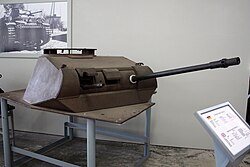Top Qs
Timeline
Chat
Perspective
2 cm KwK 30
German 2 cm cannon From Wikipedia, the free encyclopedia
Remove ads
The 2 cm KwK 30 L/55 (2 cm Kampfwagenkanone 30 L/55) was a German 2 cm cannon used as the main armament of the German Sd.Kfz.121 Panzerkampfwagen II light tank and various reconnaissance vehicles. It was used during the Spanish Civil War and the Second World War. It was produced by Mauser and Rheinmetall-Borsig from 1935.[2]
The KwK 30 also served as the basis for the 20 mm C/30, an aircraft variant mounted experimentally in some Heinkel He 112 fighters and proved to make an excellent ground-attack weapon during the Spanish Civil War. Direct ground-attack was not considered a priority for the Luftwaffe and thus, the cannon was not used on other designs.[3]
An improved version, the 2 cm KwK 38 L/55 (2 cm Kampfwagenkanone 38 L/55), was introduced in 1942 and mounted mainly on armored cars. The KwK 38, equipped with the longer L/65 Flakbarrel, was used on the Panzer II Luchs and also on the Sd.Kfz.251/17 Schützenpanzerwagen (2 cm) Platoon leader vehicle, which had the gun on a pedestal mounting with a small armored turret to protect the gunner.
Remove ads
Vehicles mounted on
Ammunition
Summarize
Perspective
The 2 cm KwK 30 used the 20×138mmB cartridge. Average penetration performance established against rolled homogenous steel armor plate laid back at 30° from the vertical.[4]
- PzGr.39 (Armour Piercing) (Armor penetration: 23 mm at 100 meters and 14 mm at 500 meters)
- PzGr.40 (Armour Piercing Composite Rigid) (Armor penetration: 40 mm at 100 meters and 20 mm at 500 meters)
- 2 cm Sprgr. 39 (High Explosive)
Remove ads
References
Wikiwand - on
Seamless Wikipedia browsing. On steroids.
Remove ads

